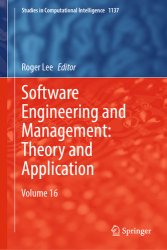 Название: Software Engineering and Management: Theory and Application: Volume 16
Название: Software Engineering and Management: Theory and Application: Volume 16Автор: Roger Lee
Издательство: Springer
Серия: Studies in Computational Intelligence
Год: 2024
Страниц: 238
Язык: английский
Формат: pdf (true), epub
Размер: 31.9 MB
The book reports state of the art results in Software Engineering Research, Management & Applications in both printed and electronic form. SCI (Studies in Computation Intelligence) has grown into the most comprehensive computational intelligence research forum available in the world.
Federated Leaning (FL), as a distributed Machine Learning paradigm, enables the collaboration of a group of agents to collaboratively conduct a learning model training, while preserving the data privacy. Federated Learning is viable distributed Machine Learning framework that can be applied to different smart-world systems, supported by the advancement of rapidly growing networking and computing techniques. Federated Learning (FL) has made possible the collaborative training of Machine Learning models between aggregation server and clients without sharing their private data. With the massive volume of heterogeneous data from various clients, the server faces challenges such as data unbalance, data corruption, and/or data irrelevancy. As a result, the FL setting is exposed to numerous security risks that lead to performance deterioration of learning effectiveness. To tackle the issue, in this paper we propose the Heterogeneity Index Based Clustering (HIC) approach, which enables the dynamic categorization of clients into clusters. Particularly, the model weights are dynamically clustered based on their heterogeneity level using an affinity propagation method. The HIC approach uses a simple, but effective way of scaling data heterogeneity and dynamic clustering to create a resilient learning system against backdoor attacks that outperforms the existing works on FL robustness. Our experimental results demonstrate that the clustering client’s weight based on their heterogeneity level decreases data unbalance and reduces attack success rate, increasing model performance, and encouraging clients’ contribution in FL.
Stochastic gradient descent (SGD) and Alternating least squares (ALS) are two popular algorithms applied on matrix factorization. Moreover recent researches pay attention to how to parallelize them on daily increasing data. About large-scale datasets issue, however, SGD still suffers with low convergence by depending on the parameters. While ALS is not scalable due to the cubic complexity with the target time rank. The remaining issue, how to operate system, almost parallel algorithms conduct matrix factorization on a batch of training data while the system data is real-time. In this work, the authors proposed FSGD algorithm overcomes drawbacks in large-scale issue base on coordinate descent, a novel optimization approach. According to that, algorithm updates rank-one factors one by one to get faster and more stable convergence than SGD and ALS. In addition, FSGD is feasible to parallelize and operates on a stream of incoming data. The experimental results show that FSGD performs much better in solving the matrix factorization issue compared to existing state-of-the-art parallel models.
In recommender system, the data can be divided into two main groups: the first group is the rating data (user evaluate to the product; the second one is textual data through comments, product descriptions … Starting from these input data types, the recommender system model is also divided into two main models: a collaborative filtering model (CF) using rating matrix and content- based model (CB) using textual data. While the CB model is suitable with text semantic analysis to generate product and ignores the relationship between users or items, CF is widely used with more accuracy based on the relationship between the users and items. In the previous work, the authors have proven that integrating the sentiment analysis problem for text data and the matrix factorization of CF is feasible and brings precisely predictive results.
Phishing is a common approach that cybercriminals use to steal sensitive information from individuals and organizations. Messaging apps, phone calls, social media, and emails are just a few of the many platforms that phishing attacks target. Phishing emails, a type of cyberattack using fake emails, are difficult to recognize due to sophisticated techniques employed by attackers. In this paper, we use a natural language processing (NLP) and Machine Learning (ML) based approach for detecting phishing emails. We compare the efficacy of six different ML algorithms for the purpose. An empirical evaluation on two public datasets demonstrates that our approach detects phishing emails with high accuracy, precision, and recall. The findings from this work are useful in devising more efficient techniques for recognizing and preventing phishing attacks.
Smartphones are equipped with a wide variety of sensors, which can pose significant security and privacy risks if not properly protected. To assess the privacy and security risks of smartphone sensors, we first systematically reviewed 55 research papers. Driven by the findings of the systematic review, we carried out a follow-up questionnaire-based survey on 23 human end-users. The results reflect that the participants have a varying level of familiarity with smartphone sensors, and there is a noticeable dearth of awareness about the potential threats and preventive measures associated with these sensors. The findings from this study will inform the development of effective solutions for addressing security and privacy in mobile devices and beyond.
Скачать Software Engineering and Management: Theory and Application: Volume 16